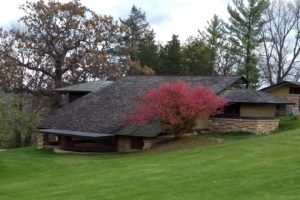As we walked into the recreated Dutch village from the Netherlands’ Holland province on Windmill Island, our friend Cindy, who has been to the Netherlands, said that it reminded her of her visit overseas. Her mom’s side of the family and my dad’s side of the family both have a Dutch background, so I’m really glad to be here.


During the spring thaw and when heavy rains fall, the swollen Black River can cause serious damage the dykes at the east end of the canal as the water rushes toward to Lake Macatawa. For protection, the park installed this sluice gate. It’s made of planks that are 10′ long, 12′ high, and 4″ thick. A handwheel is used to lower it as a barricade against the flowing river. Under normal conditions, the gate is raised so the water can flow naturally.






In 1959, Sipp Houtman, the original designer took over its operation when he retired, and he kept adding to it. The exhibit was moved to Windmill Island in 1966. Some of the notes with the display pictures came from his descriptions.







At the end of the display as we turned to leave the building, this large dollhouse of a well-to-do home was in front of us.




This building was constructed in 1984 and is a splendid reproduction of the renaissance period. The sign says to notice the intricate brick work underneath the gutters, the lovely stepgables with lion heads, the slate-like tile roof, and interesting shutters.
Inside this lovely building are examples of Dutch handiwork that were for sale. Also for sale were boxes of Dutch cookies that we finally tried. Wish I had bought some to bring home.
wood bowls

Then I saw the sign for the Holland Bowl Mill that made these bowls. We have to find the shop. Let’s learn about how the owners of this factory make their hardwood bowls.
Bowl making used to be a valued trade that was passed down through generations of families. Because of all the inexpensive materials available to mass produce tableware today, handcrafted wooden bowls like these are now a specialty item, and the craft is almost a lost art.

Such American hardwoods as beech, cherry, walnut, and hard maple are used for the bowls. The timber is harvested from forests throughout Michigan, Indiana, and Ohio. Hardwoods from other countries aren’t used, because much of that wood is harvested in unsustainable ways and isn’t subject to our standards.
Maintaining the environment is an ongoing part of the mill’s business and is included in all decisions dealing with producing wood products. Only the larger diameter trees are harvested so the smaller, less mature trees can grow in their place. Removing the huge canopies of leaves from the larger trees allows sunlight to penetrate the forest floor and reach the young foliage and the wildlife. This process is called select cutting. Logs delivered to their mill are in 8′, 10′, and 12′ lengths, and no logs under 16″ in diameter are accepted.
After arrival, each log is cut into large blocks and then again into bowl blanks. The larger blanks produce a 17″, 15″, 12″ and 9″ bowl. The smaller bowl blanks produce a 10″, 8″, 7″, and 6″ bowl. This process is called nesting because each of the bowls nest inside of another.
Wood that cannot be used for bowls is used in other ways so that nothing goes to waste or is put into a landfill. Such uses are firewood for heating homes, fireplaces, or camp fires. Shavings and fine turnings are used for animal bedding. Every part of the log is used.

We’ll show you our visit to the Holland Bowl Mill in the next post.
delft pottery

But how do we know if delftware is “real”? Making pottery in Holland began over 400 years ago as a reproduction of Chinese “Ming” porcelain. Today China produces large quantities of cheap copies of the typically windmill-patterned delftware.
Having a factory mark on the bottom of each piece isn’t the best way to find true delftware, because souvenir-quality items often have a crown on the bottom. However, factories with “Royal” designations have never used a crown in their marks.
Also, the term “handpainted” isn’t a guarantee either. The detail in screen-painted or decaled pieces can be very precise since the original artwork is created once before copies are made.

wooden shoes
This poster reminded us of the process for making wooden shoes that we read about in an earlier post when we were at the Deklomp Wooden Shoe Factory at Veldheer Tulip Farm.


For a little bit of humor and wisdom, I’ve typed out the Wooden Shoe Wisdom by Sipp Houtman (the man responsible for the Dutch village model that we’ve enjoyed).

- Put your wooden shoes on backwards before advising your friend where to fish or whom to marry.
- A wooden shoe carved from green wood dries without cracking—a child disciplined while young grows up even-tempered.
- Find no fault with a man until you have worn his wooden shoes for one winter.
- A man without a wife walks with but one wooden shoe.
- Marriage is like new wooden shoes; one must learn to walk in them.
- A son follows his father’s wooden shoes, not his words.
- Should your child address you in hard words, apply a wooden shoe to his soft parts.
- Father, tuck your temper in a wooden shoe outside the door; give your family tenderness they’ll ask for little more.
- Grandpa said, “Get your Sunday wooden shoes large enough to stuff with straw. Churches are cold and sermons long; warm feet good Christians make.
- Mother’s wooden shoe and daughter’s wooden shoe are of a pattern, as mother is, so daughter likely will be—neat or slattern.
- A rich man lived but to skimp and save, a poor man only spent and gave—each wears but two wooden shoes in his grave!
Back outside, we saw this authentic Dutch mailbox.



Since we’ve looked at the wooden bowls made here in Holland, let’s go to the factory next.




